Nevados de Ecuador y Quito Colonial, Ángel N. Bedoya Maruri, 1976
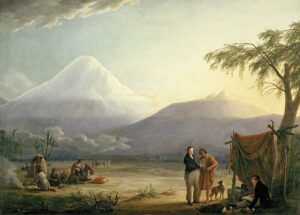
Alexander von Humboldt and Aimé Bonpland at the foot of Chimborazo Volcano. Autor: Friedrich Georg Weitsch (1758–1828)
During his stay of almost eight months in the Province of Quito, Humboldt spent part of his time visiting the volcanoes and examining the peaks of Pichincha, El Corazón, Antisana and Illiniza one by one, from fifteen days to three weeks in each one of them and always returning at intervals to the city; from where he left on June 9, 1802 to the surroundings of Chimborazo located in the southern part of the province.
From Lima he communicated to his brother Wilhelm:
“On our trip to the Antisana volcano the weather was so favorable that we climbed to a height of 2,773 toises (5,407 mt). The barometer went down in this high region to 14 inches and 27 lines and the low density of the air made us gush blood from our lips, gums and even our eyes. We felt extremely weak and one of our companions vanished. Until now it had been believed impossible to climb higher than the summit of El Corazón, which La Condamine had reached and whose height is 2470 toises. The analysis of the air brought from the highest point of our trip gave us 0.008 of carbonic acid over 0.219 of oxygen”
Source: Diario el Comercio, article "Rústica casa a los pies de un volcán evoca el paso de Alexander Von Humboldt por Ecuador", July 15, 2017
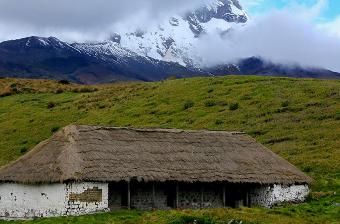
House where Humboldt lived some weeks while visiting the Antisana (1802)
Amid the cold and surrounded by grasslands at the foot of the Antisana volcano, a rustic postcard-worthy house recalls the passage more than two centuries ago through the Ecuadorian mountain range of the German naturalist Alexander Von Humboldt, labeled in some biographies as the "father of Modern Geography".
Located in an area acquired by the Quito Drinking Water Company (EPMAPS), to protect the vital liquid that goes to the south of the Ecuadorian capital, this house stands with adobe masonry and a wooden structure that supports the ceiling straw.
The house is "testimony to the ascension of Humboldt. He was in Antisana, in Chimborazo, making a very detailed, very scientific description of the plants and fauna that were in the country at that time," says Pablo Lloret, manager of Environment of (EPMAPS).
Their studies served so that "many" ecologists and environmentalists could "determine a kind of starting line, a baseline of many species: where they were, at what altitudes and how they behaved at the time" compared to what you have Now, aim.
For those who find the house in one of the corners of the paramo, surrounded by disheveled grasslands in the wind, and unaware of its importance, a small plaque placed on March 16, 2002 shows its noble tenant.
"HUMBOLDT. 200 years ago, on a day like today, Alexander von Humboldt, glory of science and true discoverer of America, visited and ascended Antisana to unravel its secrets," reads an already deteriorated sheet of metal on the front of the House.
Viajes Científicos a los Andes Ecuatorianos, M. Boussingault, 1849
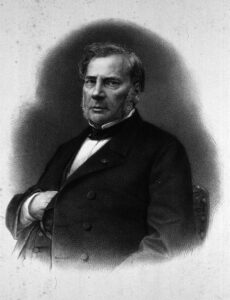
Jean Baptiste Boussingault, french chemist (February 02, 1802 – May 12, 1887).
Regarding the temperature of the lower limit of the permanent snows below the Equator, I have adopted that of 1 ° 5 cent, given by M. de Humboldt. Hoping to collect some data on the temperature of the snow-capped mountains, I went up to many: in the Antisana at a height of 5460 meters, I discovered a cavern in the ice, but the ground was so shaky that it didn't seem prudent to enter Alone, and the Indian who was accompanying me and who could have restrained me with a rope, was suddenly attacked with vertigo, with frequent pulsations, a burning face and dislocated eyes. I could barely observe my thermometer in a 14-inch hole. deep at the entrance to the cavern; the temperature he indicated was one degree and seven below zero, - 1 ° 7, while another thermometer in the open air and in the shade indicated zero at the same time.
I decided to go up to the Antisana a second time, and make another attempt to enter the cavern, but that same night we were blind, Colonel Hall who had stayed on the snowy square, the Indian, a black man carrying the barometer and myself. After my healing, I made some excursions on the snow-capped mountains, but I was never fortunate enough to find a place like that in the Antisana on purpose to determine the average temperature.
Nevados de Ecuador y Quito Colonial, Ángel N. Bedoya Maruri, 1976
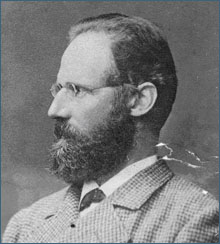
Wilhelm Reiss (13 June 1838 – 29 September 1908), German geologist and explorer
On January 8, 1872, he left Quito through the deep region of the Chillo Valley until nightfall in Pintag where he spent the night while organizing the expedition personnel; thereafter, he had to tolerate the slow movement of the sixteen muleteers caravan in continuous disputes with "hairy peons" and only two days later he was able to reach the last house, located in the middle of the paramo at 4,075 m. high, at the foot of the snowy mountain.
What was the picture he contemplated?
“From the house and especially from a nearby hill, the view is wonderful, very immediately the three snow-capped domes of the Antisana massif rise, into whose crater the eye penetrates through a deep ring road: Chuzalongo and Chacana are shown to the north and towards the south it embraces in the foreground innumerable low hills and great plains and among them numerous lakes the largest of these Micacocha passes half a league long (3,951 m.) ”.
“But the greatest look presents the Antisana, whose slopes covered with formidable masses of snow and ice change from time to time according to sunlight. Completely fresh lava flows from the pristine canopy...”
Travels amongst the Great Andes of the Equator, Edward Whymper
On March 9, at 12.55 p.m., we started again; got the caravan to the foot of the moraine at 2.40, and all the baggage up to the camping-place (15,984 feet) by 4 p.m. Our natives with Verity then returned to the hacienda, leaving us at the extreme top of the moraine on the right bank of the glacier, which forms a tail or lower prolongation of the basin in the centre of the engraving.
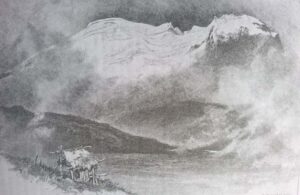
A fierce hail-storm occurred while we were on the way, and snow fell heavily afterwards; yet the temperature did not descend so low as the freezing-point in the night, and at 4 a.m. on the 10th it stood at 40°5 Faht.
The weather seemed very doubtful in the morning, and we delayed until daybreak, to see how it would develop. The Carrels and I got away at 5.38 a.m., and travelled quickly, through deriving considerable benefit from the track made on the 7th, which was well seen, although several inches of snow had recently fallen. At 7.30 a.m. clouds formed around the highest point of the mountain, and it remained invisible until the afternoon. At about 8 a.m., when approaching the summit ridge, we got into a labyrinth of crevasses, and had difficulty in finding a way amongst them. The chasms in the ice on the upper part of Antisana are of great size,—some, as much as half a mile long, two hundred and fifty feet deep, and sixty to eighty feet across. One of the larger ones was crossed by a snow - bridge; and, although tied widely apart, all of us were on the bridge at the same time. Above this the slopes steepened, and ominous cracking sounds occurred. All three exclaimed simultaneously, "I fear an avalanche." But no snow-slip happened, and presently the gradients lessened, ceased, and the slopes fell away in front.
My cherished dream of a boundless view over the Amazonian basin was annihilated in that instant. Nothing could be seen through the mists that encircled the mountain. The snow still rose on our left, and we bent round to the north, and after a few hundred yards it fell away on that side. Then we bore north-west, west, south-west, south, south-east and round to north again, always keeping the rising snow against the left shoulder. At last we could perceive no tendency to rise or fall in any direction, and came upon a nearly level plain of snow, lost in mist on all sides. This was the summit.
It was still early in the day, and we reposed upon the snow, around the barometer, in air so calm that it could scarcely be said to blow from any quarter. At 10.20 a.m. the barometer… If this determination and that subsequently made of Cayambe are correct, Antisana is the third in rank of the Great Andes of the Equator.
After we had descended a short distance the clouds cleared sufficiently to let it be seen that we had been on the top and to shew that the snowy portion of the mountain extends for a long distance to the north-east. As there was still time to spare, we made a detour, in search of craters, to the curved ridge which connects the nearer peaks of Antisana with the more distant ones in the engraving; and looked down upon some exceedingly precipitous glacier on the other side. We saw no open crater, nor anything suggestive of one on any part of Antisana; though, on March 7, when arrested at the edge of the great crevasse, several puffs of strongly sulphurous vapour reached us. Dr. W. Reiss, however, says,1 in the Proceedings of the Geographical Society of Berlin for 1880, that there is a crater, opening towards the east, filled with a glacier (from which a stream flows that is impregnated with sulphur), and I presume that he must refer to the glacier basin we saw beneath us.
An hour later we were at the bottom of the snow-slopes, with only about a mile of slightly descending and nearly flat glacier between ourselves and the tent,—having just discussed whether the rope should be taken off, to move with greater freedom, and decided against it, as we were so near home; striding along at our best pace, about fifteen feet apart, Louis in front and Jean-Antoine last, keeping step as we walked. In the twinkling of an eye the surface gave way, and I shot down, as it were through a trap-door, nearly pulling both men over; and in the next second found myself dangling between two varnished walls of glacier, which met seventy feet beneath.
The voices of the cousins were nearly inaudible, for the hole was no bigger than my body, and they could not venture to approach it. With slow and anxious pulls they hauled away, fearing that the rope would be severed by the glassy edges; but, before my head touched the bridge, more of the brittle structure yielded, and I went down again. This was repeated several times, and then Jean-Antoine, seeing that their efforts must be ineffectual so long as they were on opposite sides, leaped the chasm; and, with united pulls, the two cousins landed me with a jerk, through the frozen vault and its pendent icicles, on to the surface, poorer by a cap, though not otherwise the worse for the immersion.
In twenty minutes we arrived at the camp, where the others were already in waiting, and by 6.40 p.m. we were back at the Hacienda, having spent some time on the way in adding to our collections…
Book Montañas del Sol, written by Serrano, Rojas and Landazuri
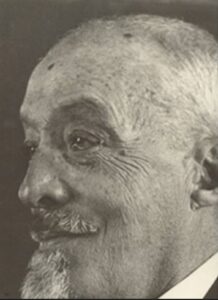
Augusto Nicolás Martínez: Ecuadorian scientist, climber, farmer, researcher and educator, Ambato 1860 - 1946.
At 4 in the afternoon, after crossing the beautiful Chillo Valley, we reached the town of Pintag where we were stopped, for more than an hour, by a furious storm of lightning and hail. I have never seen a storm like this: it seemed like a cataclysm, a beginning of the end, a return to chaos; the lightning followed one another without interruption: I could count up to twenty-five lightnings in a minute and the falling hail was enormous, some measuring more than 2 cm in diameter. When the calm returned, after 5 in the afternoon, we continued on our way with some rain still and thus we reached the famous alleys of Yana-Compañía. Anyone who has not walked them after the rain doesn't know what these alleys are: deep ditches with sloping and uneven ground, with perpendicular slopes and crowned with brush; rained that's hellish, and without the enormous layer of hail accumulated in the bottom, in which the oars of the horses sank to the kneecaps, we would not have reached Pinantura with healthy bones.
But with everything, the happy alleys of Yana-Compañía, is not the worst part of the road, because, a little further on is the Guapal gorge, which forms the desideratum of the lousy roads ...
We arrived at the gigantic helera that the Indians call "Los Crespos", located to the Southwest; it was impossible to go up there. This is a pile of huge forests of ice, crevices, caves, cliffs, streams; it would seem that they are the ruins of an immense, incomparable marble monument, destroyed by a supernatural power. it's to be seen how the light plays in this crowding of icebergs; all the imaginable colors are found there in a magnificent cavern, formed by blue ice, where it escapes the torrent that passes in front of the house, and whose course we have followed. Throughout the length of the snowdrift, mysterious noises are heard, as if the immense mass of ice was animated.
